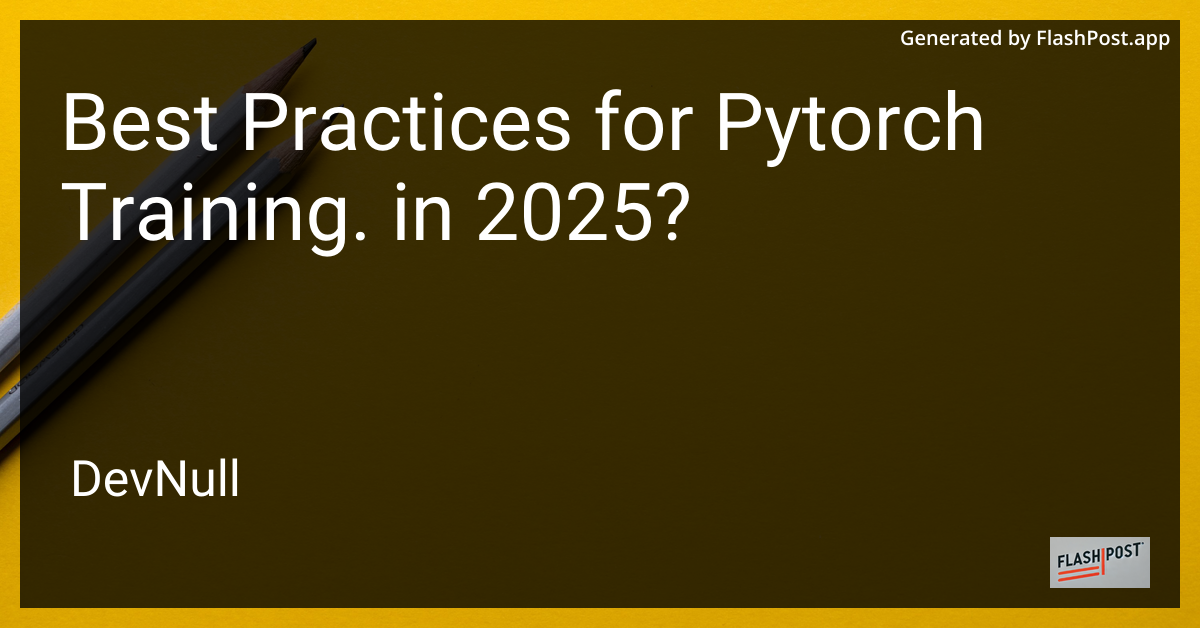

Best Practices for Pytorch Training. in 2025?
As machine learning continues to evolve and expand its reach, PyTorch remains a popular framework for deep learning practitioners. As of 2025, new techniques and tools have emerged, enhancing training efficiency and effectiveness. Let’s explore the best practices for PyTorch training, incorporating the latest innovations and providing links to essential resources.
Best PyTorch Books to Buy in 2025
| Product | Features | Price |
|---|---|---|
 Machine Learning with PyTorch and Scikit-Learn: Develop machine learning and deep learning models with Python | Buy It Now  | |
 Deep Learning for Coders with Fastai and PyTorch: AI Applications Without a PhD | Buy It Now  | |
 Deep Learning with PyTorch: Build, train, and tune neural networks using Python tools | Buy It Now  | |
 PyTorch Pocket Reference: Building and Deploying Deep Learning Models | Buy It Now  | |
 Mastering PyTorch: Create and deploy deep learning models from CNNs to multimodal models, LLMs, and beyond | Buy It Now  |
1. Utilize Advanced PyTorch Optimizers
Choosing the right optimizer is crucial for efficient model training. In 2025, advancements in optimizer algorithms ensure faster convergence and better model performance. AdamW and RAdam have become popular choices due to their adaptive learning rate and weight decay capabilities. These optimizers help in stabilizing training and achieving superior results.
For more detailed guidance on updating model parameters using optimizers in PyTorch, check out this comprehensive guide on PyTorch optimizers.
Best PyTorch Books to Buy in 2025
| Product | Features | Price |
|---|---|---|
 Machine Learning with PyTorch and Scikit-Learn: Develop machine learning and deep learning models with Python | Buy It Now  | |
 Deep Learning for Coders with Fastai and PyTorch: AI Applications Without a PhD | Buy It Now  | |
 Deep Learning with PyTorch: Build, train, and tune neural networks using Python tools | Buy It Now  | |
 PyTorch Pocket Reference: Building and Deploying Deep Learning Models | Buy It Now  | |
 Mastering PyTorch: Create and deploy deep learning models from CNNs to multimodal models, LLMs, and beyond | Buy It Now  |
2. Conduct Extensive Hyperparameter Tuning
Hyperparameter tuning remains a critical step in maximizing model performance. In 2025, automated hyperparameter tuning tools, such as Optuna and Ray Tune, are widely used. These tools leverage advanced algorithms and distributed computing to efficiently explore the hyperparameter space, allowing you to find the optimal settings more quickly.
Learn more about performing hyperparameter tuning in PyTorch from this insightful article.
Best PyTorch Books to Buy in 2025
| Product | Features | Price |
|---|---|---|
 Machine Learning with PyTorch and Scikit-Learn: Develop machine learning and deep learning models with Python | Buy It Now  | |
 Deep Learning for Coders with Fastai and PyTorch: AI Applications Without a PhD | Buy It Now  | |
 Deep Learning with PyTorch: Build, train, and tune neural networks using Python tools | Buy It Now  | |
 PyTorch Pocket Reference: Building and Deploying Deep Learning Models | Buy It Now  | |
 Mastering PyTorch: Create and deploy deep learning models from CNNs to multimodal models, LLMs, and beyond | Buy It Now  |
3. Implement Effective Early Stopping
Preventing overfitting and ensuring convergence are essential during training. Early stopping mechanisms have advanced in 2025, with smarter heuristics to determine when a model has truly converged. These methods help save computational resources and avoid unnecessary training epochs.
For guidance on loading early stopping counters and enhancing neural network convergence in PyTorch, visit this helpful resource.
Best PyTorch Books to Buy in 2025
| Product | Features | Price |
|---|---|---|
 Machine Learning with PyTorch and Scikit-Learn: Develop machine learning and deep learning models with Python | Buy It Now  | |
 Deep Learning for Coders with Fastai and PyTorch: AI Applications Without a PhD | Buy It Now  | |
 Deep Learning with PyTorch: Build, train, and tune neural networks using Python tools | Buy It Now  | |
 PyTorch Pocket Reference: Building and Deploying Deep Learning Models | Buy It Now  | |
 Mastering PyTorch: Create and deploy deep learning models from CNNs to multimodal models, LLMs, and beyond | Buy It Now  |
4. Leverage Data Augmentation and Regularization Techniques
To enhance model generalization, implement data augmentation and regularization techniques. In 2025, techniques such as cutmix, mixup, and label smoothing have become standard practices. These methods increase the robustness of models by providing varied training data and slightly altered labels, reducing overfitting.
Best PyTorch Books to Buy in 2025
| Product | Features | Price |
|---|---|---|
 Machine Learning with PyTorch and Scikit-Learn: Develop machine learning and deep learning models with Python | Buy It Now  | |
 Deep Learning for Coders with Fastai and PyTorch: AI Applications Without a PhD | Buy It Now  | |
 Deep Learning with PyTorch: Build, train, and tune neural networks using Python tools | Buy It Now  | |
 PyTorch Pocket Reference: Building and Deploying Deep Learning Models | Buy It Now  | |
 Mastering PyTorch: Create and deploy deep learning models from CNNs to multimodal models, LLMs, and beyond | Buy It Now  |
5. Embrace Mixed Precision Training
With the rise of powerful GPUs and specialized hardware, mixed precision training is now more accessible in 2025. Using lower precision, such as float16, reduces memory usage and increases training speeds without compromising model accuracy. PyTorch’s built-in support for mixed precision training through torch.cuda.amp makes it easier to implement.
Best PyTorch Books to Buy in 2025
| Product | Features | Price |
|---|---|---|
 Machine Learning with PyTorch and Scikit-Learn: Develop machine learning and deep learning models with Python | Buy It Now  | |
 Deep Learning for Coders with Fastai and PyTorch: AI Applications Without a PhD | Buy It Now  | |
 Deep Learning with PyTorch: Build, train, and tune neural networks using Python tools | Buy It Now  | |
 PyTorch Pocket Reference: Building and Deploying Deep Learning Models | Buy It Now  | |
 Mastering PyTorch: Create and deploy deep learning models from CNNs to multimodal models, LLMs, and beyond | Buy It Now  |
Conclusion
Staying updated with best practices in PyTorch training is crucial for building efficient and effective machine learning models in 2025. By utilizing advanced optimizers, conducting thorough hyperparameter tuning, implementing early stopping, adopting data augmentation, and embracing mixed precision training, you can achieve superior results.
For further reading, refer to the comprehensive guides linked throughout this article to deepen your understanding and improve your PyTorch training workflows.
